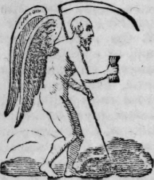Time
Description
This section is from the book "The Corner Cupboard; Or, Facts For Everybody", by Robert Kemp Philp. Also available from Amazon: The Corner Cupboard; or Facts for Everybody.
Time
Time. The measure of motion, and of the succession of thoughts, determined on our globe by the phenomena of light and darkness, and returning seasons of heat and cold; the earth's motion round its axis being a day, and its motion round the sun a year; while the period from new moon to new moon determines the month. Longer periods are the moon's cycle of recurring phenomena in nineteen years; the earth's cycle, or the retrocession of the equinoctial points round the ecliptic in 25,600 years; or the revolution of the line of apsides in 20,900 years. These are periods of duration relative to our globe and to us; but different to different systems, and even to different animals and states on the same planet; yet all are included in a totality of simple duration, common to the whole universe, and which totality is necessarily without measure, parts, begin-ing, or ending. Time is, therefore, an acquired plan or mode of considering motions or events, and our views can have no exact relation to its absolute properties as an universal totality. Everything is relative which is not infinite; and all are evolved and absorbed by the totalities of infinite time and space. Time in the ancient mythology was drawn as an old man, with a scythe and hour-glass.

60 Seconds | 1 minute. |
60 Minutes | 1 hour. |
24 Hours..... | 1 day. |
7 Days | 1 week. |
4 Weeks | 1 month.* |
13 Months 1 day 6 hours . | 1 year. |
365 Days...... | 1 common year |
366 Days | 1 leap year. |
100 Years........ | 1 century. |
*A Lunar Month contains 28 days, being the time in which the moon revolves round the earth. A Solar Month is the space of time in which the sun passes through a sign of the zodiac. A Solar Year is generally reckoned to contain 365 days, 6 hours; but the exact time in which the earth performs its annual revolution round the sun is 365 days, 6 hours, 9 minutes, and 11 seconds. Dividing the year of our Lord by 4, we know whether or not it is leap-year, by there being, or not being, a remainder. Thus, 1824 divided by 4, leaves no remainder and is therefore leap-year. The year 1800 was an exception, and so will be 1900, a day dropt in a hundred years being necessary to keep the calculations accurate. In the year 1582, it was observed by Pope Gregory Xlll., that since the commencement of the Julian calculation of 365 1/4 days to the year, it had exceeded the true time 10 days; and therefore he ordered 10 days to be taken from the calendar, and the 11th of March to be accounted the 21st. The Pope's edict was generally observed by the nations subject to his authority, but the Protestant countries continued the use of the Julian reckoning, which gave rise to the two modes of computation that yet prevail in Europe, called the old style and new style. The New Style was adopted in Britain, by Act of Parliament, in the year 1752, when the 1st of September was called the 12th. Still the calendar, according to the present calculation, will exceed the true time by 3 hours in every 400 years.
Continue to:


